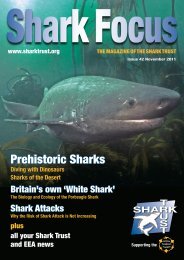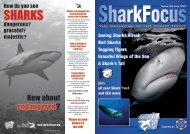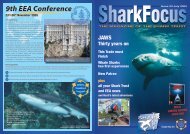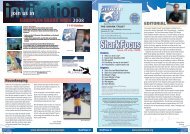Shark Focus
No Limits? - The Shark Trust
No Limits? - The Shark Trust
You also want an ePaper? Increase the reach of your titles
YUMPU automatically turns print PDFs into web optimized ePapers that Google loves.
The <strong>Shark</strong>safe Barrier Project:A new and eco-friendly solutionto detrimental beach netsby Craig O’ConnellPh.D. Candidate, University of Massachusetts, Dartmouth<strong>Shark</strong>s are perfectly evolved predators occupying a wide range of ecological niches, andplay a key role in maintaining the delicate balance within marine ecosystems. However,over time, certain shark species have been construed as ‘man-eaters’ – a misconceptionthat has played a role in the substantial declines observed in many shark populations.As a marine scientist I see this negative reputation as wholly undeserved. Over the pastseven years my research has required me to share water with White <strong>Shark</strong>s Carcharodoncarcharias, Bull <strong>Shark</strong>s Carcharhinus leucas, Great Hammerhead <strong>Shark</strong>s Sphyrna mokarran,and Tiger <strong>Shark</strong>s Galeocerdo cuvier, outside the confines of a cage. Although I was understrict supervision, these encounters remained peaceful, with the mutual curiosity betweenthe sharks and myself making for some of the most interesting moments of my life. If donecorrectly (e.g. avoiding murky waters that contain sharks and avoiding recreational activitiesthat result in motivational stimuli located in close proximity to bathers or yourself), negativeincidents can be minimised.Beach netting programmesBesides having a poor reputation, populations of manyshark species have declined due to a variety of sourcesof anthropogenic (human-induced) mortality, includingbeach netting programmes. Beach nets are deployedin several locations around the world and are used tominimise shark populations, as a means of reducingthe probability of an exceedingly rare encounterbetween a water-user and a predatory shark. Althoughbeach nets are highly successful at killing sharks,there are several aspects of netting programmes whichremain misunderstood and misrepresented in themedia. First, these nets are not continuous betweenthe sea surface and seafloor, and thus do not fully1a1c1b1dexclude sharks from the area. Secondly, these nets arenot only responsible for shark mortality, but also for asubstantial amount of bycatch (non-target) mortality,including whales, dolphins, sea turtles, bony fish andany other species capable of becoming entangled in themeshing.In an average year, approximately 2,500 sharks arekilled within the major beach netting programmesaround the world 1 . Because, as research continuesto demonstrate, the current rate of shark mortality(from all sources) exceeds the population reboundpotential for many species, this is a major cause forconcern. Due to the inherent K-selected biologicalcharacteristics of sharks – late age of maturity, lowfecundity (producing few offspring per breeding cycle)and slow growth – the effects of the continued removalof these predators through netting programmes maybe catastrophic for local and global populations, aswell as wider marine ecosystems. For example, Myerset al.’s (2007) study demonstrated that the removalof large predatory sharks had a ‘cascading’ ecologicaleffect extending to the base of the food chain. Here, inNorth Carolina, USA, Cownose Ray Rhinoptera bonasuspopulations, released from predation by (now absent)large sharks, increased rapidly, leading to significantdepletion of commercially important Bay ScallopArgopecten irradians fisheries 2 . Although the findingsfrom this study were correlative and not causative,the implications were alarming, not only for sharkpopulations, but for ocean ecosystems also.Electrosensory overstimulationIn response to this, a variety of bycatch reductionstudies have recently been conducted, focusing onelasmobranch’s (sharks, skates and rays) uniqueelectrosensory system, known as the ampullaeof Lorenzini 3,4,5,6 (image 2). This system giveselasmobranchs the ability to detect the bioelectric fieldsassociated with prey and may also be capable of detectinggeomagnetic fields (0.25-0.65 Gauss). Using theseconcepts, scientists are exploring the use of electrosensorystimuli, such as permanent magnets, to repel sharks byoverstimulating their electrosensory system. Researchdemonstrates that magnets, when placed in associationwith baited hooks, can partially reduce shark capture;however research also demonstrates that if sharksare hungry enough, the magnet will be only minimallyeffective. Interestingly, the utilisation of permanentmagnets for more passive applications, such as swimpatternmanipulation experiments (i.e. magnets placedthroughout the water column without a bait stimulus), wasdeemed to be maximally effective.2The development of the <strong>Shark</strong>safe BarrierTherefore, research was conducted by the author on fourkey predatory shark species: the White <strong>Shark</strong> (Vulnerable– IUCN Red List), Bull <strong>Shark</strong> (Near Threatened), Tiger<strong>Shark</strong> (Near Threatened) and Great Hammerhead <strong>Shark</strong>(Endangered). This research aimed to determine: (1)if these sharks were sensitive to, and deterred by,permanent magnets and (2) if a magnetic barrier couldbe used to manipulate swim patterns. Findings fromthese studies, known as Phase I, demonstrated thatthe feeding and swimming behaviours of each specieswere highly modified by the presence of magnets (seeFigure 1). More specifically, during bait experiments,the feeding behaviours of the sharks were significantlyreduced on magnet-associated baits. Additionally, duringsmall-scale barrier trials, sharks rarely swam throughthe magnet regions of the barrier in comparison to controland procedural control regions (image 3). These data arepromising and illustrated the need for a more thoroughand large scale analysis (Phase II and Phase III).3a3bFor Phase II an international team of researchers fromthe University of Massachusetts Dartmouth (the author,Dr. Pingguo He), Stellenbosch University (Dr. ConradMatthee, Sara Andreotti), and <strong>Shark</strong> Diving Unlimited(Michael Rutzen) came together, with <strong>Shark</strong> DivingUnlimited (www.sharkdivingunlimited.com) funding theproject. For Phase II, the findings from the small-scalestudy (Phase I) were applied and a new and noninvasivetechnology, known as the <strong>Shark</strong>safe Barrier,was developed. Besides utilising permanent magnetsas potential shark deterrents, the <strong>Shark</strong>safe Barrieralso incorporates an additional interesting component.Main image: <strong>Shark</strong> warning, Byron Bay, Australia. © ScottAtkinson.Image 1: Examples of shark mortality: A] Tiger <strong>Shark</strong> displayedas a trophy at shark tournament. B] Scalloped Hammerheadcaptured on commercial longline vessel. C] Spiny Dogfishbycatch from trawling vessel. D] Nurse <strong>Shark</strong> butchered onFlorida Keys dock. © Craig O’Connell.Image 2: The ampullae of Lorenzini (red dots on snout) on aTiger <strong>Shark</strong>. © Craig O’Connell.After two decades of field observations, MichaelRutzen realised that the Cape Fur Seal Arctocephaluspusillus, a prey-favourite of the White <strong>Shark</strong>, utiliseskelp forests in Gansbaai, South Africa, as an antipredationmechanism. If these seals can outmanoeuvrea motivated White <strong>Shark</strong> and find refuge within a highdensitykelp forest, the White <strong>Shark</strong> will rarely continuepursuit, continually encircling the kelp forest, althoughnot entering into it.4Therefore, the team has intertwined the magnetictechnology with large vertical pipes that resemble kelp,creating a device that provides promise as a White<strong>Shark</strong> deterrent, or more specifically, a device that canmanipulate the swim patterns of this formidable predator(image 4). Furthermore, because the magnets are atechnology that specifically targets the electrosensorysystem of elasmobranchs, the <strong>Shark</strong>safe Barrier is‘elasmobranch-specific’, and data illustrate that theswimming patterns of other marine organisms (i.e. CapeFur Seals and teleosts) are not observably impacted bythe barrier.Figure 1. The compiled avoidance and feeding behaviourstowards control (C) and magnet (M) associated baits of 20different White <strong>Shark</strong>s during the bait experiment of PhaseI. The data clearly demonstrate that avoidance behaviourswere higher and feeding behaviours were lower towards Massociated baits illustrating that White <strong>Shark</strong>s are sensitiveto permanent magnetic fields. Figure taken from O’Connellet al. (2012).Image 3: Tiger <strong>Shark</strong> detection (a) and avoidance (b) awayfrom a magnetic barrier. © Craig O’Connell.Image 4: A White <strong>Shark</strong> swimming behind the <strong>Shark</strong>safeBarrier during the first season of experimental research.Although the design was promising during the first season,substantial structural modifications were made to maximise thelifespan of the barrier (5-7 years). © Jean Pierre Botha.Testing: <strong>Shark</strong> Alley, GansbaaiThis <strong>Shark</strong>safe Barrier is currently deployed in anincredibly dynamic ecosystem known as <strong>Shark</strong> Alley inGansbaai, South Africa. Besides being a cage-divingmecca, this location is also considered one of the mostideal locations on the planet to study White <strong>Shark</strong>behaviour. When weather permits, the team heads to theresearch site, commences chumming through the barrier,and collects behavioural data on the interacting White<strong>Shark</strong>s. From the first and second years of observation,the barrier has been highly successful at manipulatingthe swimming behaviours of the interacting White<strong>Shark</strong>s. With clear indications that this barrier is highlyeffective and with small-scale studies illustrating similarresults on other large predatory species of concern, thenext step is to obtain funding to conduct large-scaleexclusion experiments (Phase III). With such studies, andif Phase II continues to be successful, this barrier holdspromise as being a new and non-invasive technologythat will not only provide beachgoer safety, but will alsoserve as a shark-specific barrier that could be adoptedby current beach net/shark control programmes and usedto replace the detrimental beach nets.<strong>Shark</strong>s are an integral part of our oceans. Whenattacks do occur, we often act by making very rashdecisions (i.e. shark culls and/or deployment of beachnets). Therefore, rather than solving the problemof declining shark populations, we only amplify it.As humans, we must be more responsible for ourbehaviour and acknowledge that there are a variety ofnon-invasive precautions and preventative measureswhich can minimise the likelihood of shark-beachgoerinteraction. The key is keeping the “long term” in mind.We must think about the consequences and how ouractions may impact future generations. Although the<strong>Shark</strong>safe Barrier provides promise, what we mustrealise is that beach nets are incredibly detrimental tomarine ecosystems and thus, we must continue to findand develop new, non-invasive solutions to ensure ouroceans remain healthy for generations to come.References:1. Dudley, S.F., Gribble, N.A. 1999. Management of shark controlprogrammes. Australian <strong>Shark</strong> Assessment Report. Pgs.1-42.2. Myers, R.A., et al. 2007. Cascading effects of the loss ofapex predatory sharks from a coastal ocean. Science. 315,1846-1852.3. Brill, R., et al. 2009. The repulsive and feeding deterrenteffects of electropositive metals on juvenile sandbar sharks(Carcharhinus plumbeus). Fish. Bull. 107, 298–307.4. O’Connell, C.P., et al. 2012. The use of permanent magnetsto reduce elasmobranch encounter with a simulated beachnet. 2. The great white shark (Carcharodon carcharias)Ocean and Coast. Manag. Special Issue. http://dx.doi.org/10.1016/j.ocecoaman.2012.11.006.5. Tallack, S.M., Mandelman, J.W. 2009. Do rare-earthmetals deter spiny dogfish? A feasibility study on the useof electropositive “mischmetal” to reduce the bycatch ofSqualus acanthias by hook gear in the Gulf of Maine. ICES J.Mar. Sci. 66, 315–322.6. Rigg, D.P., et al. 2009. Do elasmobranch reactions tomagnetic fields in water show promise for bycatchmitigation? Mar. Fresh. Res. 60(9), 942–948.14 www.sharktrust.org/sharkattack <strong>Shark</strong> <strong>Focus</strong> 47 <strong>Shark</strong> <strong>Focus</strong> 47 www.sharktrust.org/senses 15
















